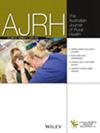Far From Help: Exploring the Influence of Regional and Remote Residence on Coastal Visitation and Participation, Risk Perception and Safety Knowledge and Practices
Abstract
Objective
To explore how self-reported coastal visitation, participation, risk perception, safety knowledge, experiences and safety practices differed between regional and remote, and major city residents to inform remoteness-specific coastal drowning prevention efforts.
Methods
This study used data obtained from the annual National Coastal Safety Survey from 2018 to 2023. Data were postweighted proportionally according to age, gender and Australian Statistical Geography Standard classification using 2021 census population data. Descriptive statistics and chi-square analyses were used to identify key differences in the behaviours, knowledge, and experiences of regional and remote respondents as compared to major city respondents.
Results
A total of 14 210 respondents were included in this dataset. Regional and remote respondents were more likely to visit an unpatrolled beach, particularly when swimming/wading (n = 929, 42.3%; χ2 = 502.14, p < 0.001). However, similar proportions of regional and remote and major city respondents reported following safety practices on patrolled beaches. Regional and remote respondents were more likely to consider sea and weather conditions for all coastal activities, but there was little difference between remoteness groups regarding rip current identification, perceptions and experiences.
Discussion
This study demonstrates that future coastal safety research should consider the impact of remoteness to corroborate the findings of this study: that a significant contributor to the regional and remote drowning burden is a lack of access to patrolled beaches.
Conclusions
Regional and remote residents are more likely to frequent unpatrolled beaches but, if able to visit a patrolled beach, are just as likely as major city residents to adhere to safety practices.

 求助内容:
求助内容: 应助结果提醒方式:
应助结果提醒方式:


